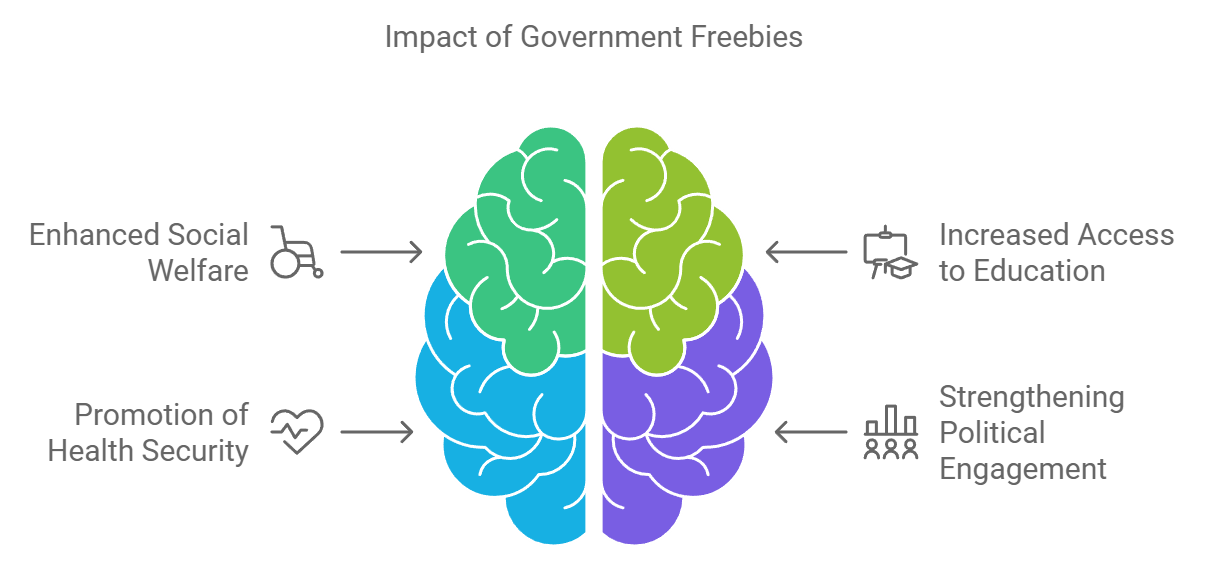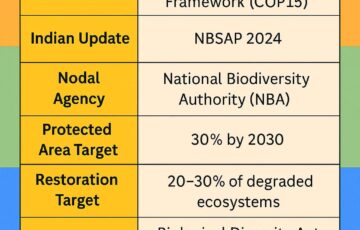Impact of Freebies on India’S Fiscal Health
Syllabus:
GS-2:
Government Policies & Interventions
Focus:
The growing trend of populist welfare schemes across Indian states is raising concerns about fiscal sustainability. As parties compete to offer financial handouts, it strains state budgets, undermines long-term economic growth, and hampers the development of essential infrastructure and services, prompting calls for policy reforms.
Introduction: The Growing Issue of Freebies
India has a long history of neglecting investments in essential public services like education, healthcare, infrastructure, and clean air, which are crucial for sustainable growth. Despite improvements at the national level, the competition among states to offer free benefits, such as cash transfers, has led to significant fiscal challenges. These handouts, while politically popular, are costly and do not address the root causes of poverty or inequality, such as improving human capital and governance.
Understanding Freebies vs Welfare Schemes:
Freebies:
- Definition: Free goods and services provided without charge to the public.
- Objective: Generally aimed at short-term benefits for targeted populations.
- Political Use: Often used for populist purposes to attract voters.
- Examples: Free laptops, TVs, bicycles, electricity, water.
- Impact: May lead to dependency and short-term satisfaction without long-term development.
- Funding: Usually funded through the government’s budget, often causing fiscal strain.
- Criticism: Can distort market dynamics and create imbalances in resource distribution.
Welfare Schemes:
- Definition: Structured programs designed to improve long-term well-being and living standards.
- Objective: Aimed at fulfilling constitutional obligations and promoting societal equity.
- Social Impact: Foster sustainable development, empowerment, and inclusivity.
- Examples: Public Distribution System (PDS), MGNREGA, Mid-day meal scheme.
- Long-term Benefits: Focus on enhancing education, healthcare, employment, and infrastructure.
- Sustainability: Prioritise economic growth, poverty alleviation, and human development.
- Criticism: Requires efficient governance and effective implementation to avoid misuse.
The Competitive Populism Problem:
- Example of Competitive Promises: Leading up to elections in Maharashtra, one party promised ₹1,500 per month to low-income women, costing ₹45,000 The opposition then raised the offer to ₹3,000. This competitive bidding between political parties across various states has escalated the fiscal burden, as 14 states now provide cash transfers to 20% of India’s women.
- Impact on Governance and Delivery: Such transfers often result in inadequate public services, as states cut capital expenditure to finance these schemes. While the expenditure may increase, the overall effectiveness in improving living standards remains limited. The transfer programs also tend to focus on food subsidies, which fail to address the structural issues that could enable women to become economically independent.
Mismatched Policies and Fiscal Strain
- Food Subsidies vs. Consumer Demand: India’s food policy subsidised food grains at a considerable cost, despite a shift in consumer demand towards other foods. The supply chains for vegetables face challenges, such as poor infrastructure and restrictions on private procurement, especially in states like Madhya Pradesh.
- Impact on Prices and Growth: Despite easing controls in some states, the lack of infrastructure, such as cold storage facilities, prevents private players from stepping in. As a result, prices for vegetables continue to rise, while the benefits of this price increase are largely captured by middlemen. The 2010s saw a similar situation, where high food inflation hindered industrial growth, and a repeat of this scenario threatens to derail economic growth again.
Potential Solutions: Governance Over Handouts
- Policy Coordination and Welfare Measures: To break the cycle of competitive populism, political parties must collaborate to agree on a minimal set of well-targeted welfare measures. This would focus on improving the quality of life for the poor while ensuring better governance and service delivery.
- Focus on Governance and Infrastructure: States should prioritise enhancing governance structures and investing in public infrastructure, especially in sectors like agriculture, rural development, and healthcare. A more coordinated approach can help reduce the dependency on temporary handouts while building long-term solutions to poverty and inequality.
- Win-Win Policies: It is better to start with small, politically acceptable reforms that benefit both the economy and the people, such as building digital platforms for better coordination, improving infrastructure, and encouraging private sector participation in sectors like agriculture and power distribution.
Key Takeaways
- Competitive Populism is escalating fiscal costs and undermining long-term growth.
- Policy Mismatches in food subsidies are distorting markets and harming growth.
- Governance and Infrastructure improvements are key to moving away from freebies and ensuring better service delivery.
- Small-Scale Reforms that focus on infrastructure and governance can be implemented with minimal political resistance.
- Collaborative Solutions are necessary to address the fiscal challenges and build a sustainable welfare system for India.
The Need for Effective Fiscal Management
- Fiscal Responsibility: States need to manage their budgets wisely by reducing unnecessary expenditures and focusing on investments that will generate long-term benefits. Excessive subsidies and freebie schemes strain the fiscal health of states and reduce the funds available for infrastructure development and public services.
- Prioritising Capital Expenditure: To ensure sustainable development, states must prioritise capital expenditure over current expenditure. Investment in infrastructure, such as transport, healthcare, and education, is crucial for fostering growth and improving the quality of life for the poor.
The Role of Technological and Structural Reforms
- Digital Platforms for Governance: Emphasising the use of digital platforms to streamline public services and improve the efficiency of government programs. Digitalization can aid in coordinating welfare measures and matching funds to specific projects, ultimately reducing leakage and enhancing accountability.
- Decentralised Pilot Projects: Starting with small, localised pilot projects in states with favourable conditions can test new policies. Successful pilots can be scaled up and replicated across other states, ensuring broader acceptance and minimising resistance to large-scale reforms.
Challenges:
- Fiscal Strain: Continuous freebies and subsidies are putting significant pressure on state budgets, diverting resources from crucial areas like infrastructure and public service delivery.
- Inefficient Welfare Programs: Populist schemes often fail to address long-term issues such as skill development, employment, and infrastructure, limiting their effectiveness in uplifting the population.
- Policy Mismatches: Existing policies, such as those focused on food grain subsidies, fail to address shifting consumer demands and infrastructure gaps, leading to price inflation and inefficient distribution.
- Over-reliance on Subsidies: Over-dependence on cash transfers and subsidies without creating enabling conditions for sustainable growth can perpetuate poverty rather than alleviate it.
Way Forward:
- Reforming Welfare Measures: Political parties must agree on minimal, well-targeted welfare measures, focusing on empowerment and sustainable growth rather than handouts.
- Enhancing Governance: Focus on improving governance at the state and local levels to ensure better delivery of public services and public resource management.
- Encouraging Infrastructure Investment: States should focus on building infrastructure, such as cold storage, rural roads, and healthcare facilities, which will have long-term economic benefits.
- Piloting New Approaches: Experiment with decentralised, technology-driven pilots in states with favourable conditions to test new policies and ensure broader acceptance.
- Collaborative Policy Making: Strengthening coordination between central and state governments to ensure policies are aligned, effective, and responsive to local needs.
Path to Sustainable Growth:
- Avoiding the Race to the Bottom: Political parties must recognize that excessive cash transfers are not sustainable in the long term. States need to move away from populist measures and focus on policy coordination that improves efficiency and governance. Effective reforms can be implemented through decentralised pilots in states with better conditions, such as Haryana, which can serve as a model for other regions.
- Long-Term Solutions: States that have embraced fiscal discipline and governance improvements, like Odisha, show that it is possible to reduce debt and invest in productive sectors. This model should be replicated across India. Conditional grants, fiscal responsibility measures, and greater transparency in government functioning can provide a sustainable path forward for both governance and development.
Conclusion:
To ensure sustainable growth, India must shift from populist freebies to effective, targeted welfare programs. A focus on improving governance, investing in infrastructure, and reducing fiscal deficits will enable states to balance welfare delivery with long-term economic stability, benefiting both current and future generations.
Source: Indian Express
Mains Practice Question:
Discuss the implications of competitive populism on India’s fiscal health. Suggest sustainable alternatives for welfare programs that promote long-term economic development while addressing immediate needs of the population.





